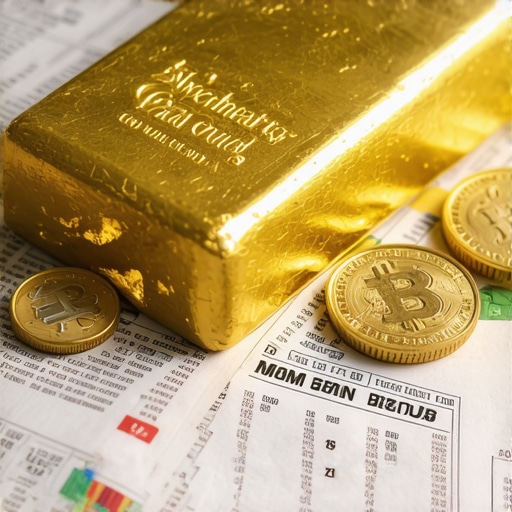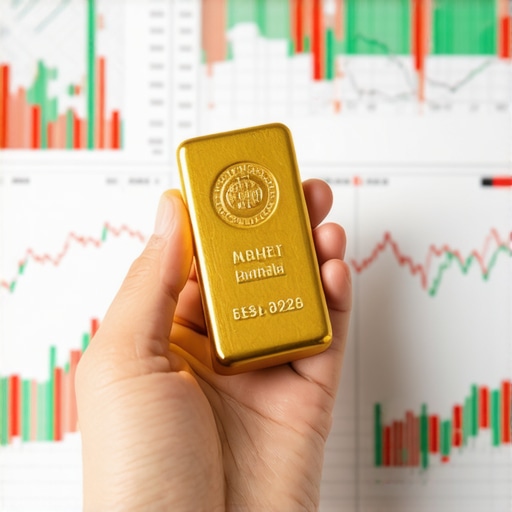Unlocking the Future of Gold Investment: Strategic Insights for 2025
As global markets evolve amidst unprecedented economic shifts, the role of gold as a resilient asset class becomes increasingly vital for sophisticated investors. In 2025, understanding the nuanced dynamics of the gold market—driven by geopolitical tensions, monetary policy adjustments, and technological innovations—can significantly enhance portfolio resilience. This guide synthesizes cutting-edge strategies, backed by expert analysis, to navigate the complex terrain of gold investing in 2025.
Why Gold Remains a Cornerstone in Diversified Portfolios
Gold has historically served as a hedge against inflation and currency devaluation. According to IMF research, its unique properties as a non-yielding asset make it an essential component for balancing risk in volatile economic environments. In 2025, this role is amplified by rising inflationary pressures and uncertain monetary policies worldwide.
Emerging Trends Shaping the 2025 Gold Market
Understanding the key drivers influencing gold prices is crucial. Factors such as increased central bank gold purchases, technological demand from the electronics sector, and geopolitical tensions in resource-rich regions are reshaping supply and demand dynamics. For a detailed analysis, explore our comprehensive market analysis.
Advanced Investment Techniques for 2025
How can investors leverage futures and options to maximize returns in a fluctuating gold market?
Futures contracts and options provide sophisticated tools to hedge risks or speculate on short-term price movements. By employing technical analysis—such as trend following and momentum indicators—investors can optimize entry and exit points. For instance, aligning futures strategies with technical analysis insights enhances decision-making precision.
Building a Resilient Gold Portfolio for 2025
Developing a long-term allocation involves diversifying across gold coins, bullion, ETFs, and mining stocks. Each instrument offers different exposure and liquidity profiles. As the market evolves, integrating emerging assets such as gold-backed cryptocurrencies could provide additional strategic avenues. For expert guidance, refer to long-term portfolio development.
What Are the Critical Questions Investors Should Ask?
How will geopolitical conflicts and global economic policies influence gold prices in 2025?
Geopolitical tensions often trigger safe-haven flows into gold, while monetary tightening may suppress prices. Staying informed through reputable sources like the market forecasts can help anticipate shifts and adapt strategies accordingly.
Explore more on how to harness expert insights for strategic gold investment and contribute your own experienced perspective to the community of financial professionals. The future of gold investing in 2025 hinges on your ability to interpret complex signals and execute with precision.
Are Gold Futures the Key to Unlocking Greater Returns in 2025?
As the gold market becomes increasingly complex, investors are seeking advanced strategies to capitalize on short-term fluctuations while maintaining long-term stability. Futures contracts and options can serve as powerful tools in this arsenal, allowing investors to hedge against volatility or speculate on price movements with precision. By combining these instruments with technical analysis—such as moving averages, RSI, and MACD—investors can identify optimal entry and exit points. For example, aligning futures positions with emerging trend signals enhances profitability and risk management. To deepen your understanding of these techniques, explore our guide on maximizing gold returns through futures and technical analysis.
How can understanding global economic indicators refine your gold trading strategies in 2025?
Key economic indicators such as inflation rates, interest rate trajectories, and currency strength profoundly influence gold prices. A rising inflation outlook often signals increased demand for gold as an inflation hedge, while tightening monetary policy may temporarily suppress prices. Monitoring reports from sources like the IMF and World Bank—such as in market analysis reports—can help investors anticipate these shifts. Integrating macroeconomic data into trading models enables a proactive approach, positioning portfolios advantageously amid evolving conditions. For more insights into macro-driven strategies, check our article on how global economic factors influence gold in 2025.
Building a Diversified and Resilient Gold Portfolio for 2025
Diversification remains a cornerstone of prudent investing. Beyond traditional gold bullion and coins, emerging assets like gold-backed cryptocurrencies and gold ETFs can enhance liquidity and accessibility. Evaluating the performance and risk profile of various instruments—such as in top gold bullion options—helps tailor a resilient portfolio. Incorporating mining stocks and futures can further diversify exposure, but requires nuanced understanding of market dynamics. For comprehensive guidance, consult our resource on developing a long-term gold investment portfolio for 2025 and beyond.
What are the emerging risks and opportunities that could redefine gold prices in 2025?
Geopolitical tensions, technological advancements, and policy shifts present both risks and opportunities for gold investors. For instance, increased central bank gold purchases—detailed in central bank buying trends—could sustain upward price momentum. Conversely, breakthroughs in digital currencies might challenge gold’s traditional safe-haven status. Staying attuned to these developments through expert analysis and market forecasts ensures strategic agility. To explore these factors further, visit our analysis on gold price forecasts for 2025.
Engage with our community by sharing your insights or asking questions about the evolving gold landscape. The key to thriving in 2025 is continuous learning and adaptive strategy implementation.
The Role of Geopolitical Dynamics in Shaping Gold’s Future Trajectory
In the complex web of global geopolitics, gold often acts as a barometer for international stability and economic confidence. Recent shifts, such as escalating tensions in resource-rich regions and evolving alliances, can induce sharp fluctuations in gold prices. For example, the recent escalation of conflict in Eastern Europe and its ripple effects on energy and commodity markets have underscored gold’s role as a safe-haven asset. According to a detailed analysis by the IMF, understanding these geopolitical signals enables investors to anticipate market movements with greater precision, leveraging geopolitical risk assessments to refine entry and exit strategies.
Integrating Macro-Economic Indicators into Sophisticated Gold Trading Models
Beyond geopolitical factors, macroeconomic indicators such as real interest rates, inflation expectations, and currency strength are pivotal in shaping gold’s price dynamics. For instance, a rising U.S. dollar typically exerts downward pressure on gold, whereas increasing inflation expectations boost its appeal as an inflation hedge. Advanced investors employ quantitative models that incorporate these indicators, utilizing tools like machine learning algorithms to predict short-term price movements. According to a comprehensive report by the Gold Market Analysis, integrating macroeconomic data into trading algorithms can significantly enhance predictive accuracy and risk-adjusted returns.
How Can Blockchain and Digital Assets Reconfigure Gold Investment Strategies?
The advent of blockchain technology and digital gold assets is revolutionizing traditional gold investment paradigms. Tokenized gold allows for fractional ownership, increased liquidity, and seamless global transactions, addressing some of the liquidity and accessibility issues associated with physical gold. Furthermore, decentralized finance (DeFi) platforms are enabling innovative hedging strategies and yield-generating opportunities that were previously unavailable. For example, platforms like Goldfinch are pioneering decentralized gold lending, providing investors with new avenues for portfolio diversification. Incorporating these emerging assets requires a nuanced understanding of blockchain technology, regulatory considerations, and market liquidity, which can be mastered through dedicated research and expert consultation.
What Are the Key Risks and Opportunities in Gold Mining and Exploration for 2025?
While price speculation is crucial, the underlying fundamentals of gold mining and exploration also offer substantial opportunities. Advances in mineral exploration technology, such as deep-sea and remote sensing geophysics, are unlocking new reserves and extending the lifespan of existing mines. However, geopolitical instability in mining regions, environmental regulations, and technological risks pose significant challenges. Investing in mining stocks or exploration companies demands an in-depth analysis of operational efficiency, geopolitical exposure, and technological innovation. For detailed insights, see the Long-term Portfolio Development guide tailored for 2025 and beyond.
Engaging with these complex factors and continuously updating your knowledge base is essential for sophisticated investors seeking to outperform in the evolving gold market landscape of 2025. Remember, the key to success lies in integrating geopolitical insights, macroeconomic data, technological innovations, and fundamental analysis into a cohesive investment strategy that adapts to rapid market changes.
Harnessing Quantitative Models to Predict Gold Price Movements in 2025
In the realm of sophisticated gold investing, leveraging quantitative analysis and machine learning algorithms has become indispensable. By integrating macroeconomic indicators such as interest rates, inflation expectations, and currency fluctuations into predictive models, investors can achieve a granular understanding of potential price trajectories. According to the Gold Market Analysis 2025, deploying these advanced analytical tools enhances decision-making precision, allowing for dynamic portfolio adjustments aligned with evolving market signals.
The Critical Role of Geopolitical Risk Assessment in Gold Strategy Formulation
Geopolitical developments continue to exert profound influence over gold prices, especially in resource-rich and politically volatile regions. Incorporating comprehensive geopolitical risk assessments—such as monitoring conflict escalation, trade tensions, and alliance shifts—into your investment framework can provide a strategic edge. Resources like the IMF research emphasize that understanding these dynamics enables investors to anticipate safe-haven flows and adjust allocations proactively.
How Will Blockchain and Tokenized Gold Reshape Portfolio Diversification?
The advent of blockchain technology and tokenized gold assets has revolutionized traditional portfolio diversification strategies. Fractional ownership via digital tokens facilitates greater liquidity, transparency, and access to global markets, thereby reducing the barriers associated with physical gold holdings. DeFi platforms like Goldfinch are pioneering decentralized gold lending, introducing yield-generating opportunities that complement conventional assets. Mastery of blockchain fundamentals and regulatory landscape is crucial for integrating these innovations effectively into your investment approach.

Emerging Risks and Opportunities in Gold Mining Technology
Technological advancements in mineral exploration, such as deep-sea and remote sensing geophysics, are unlocking new reserves and extending the lifecycle of existing mines, presenting lucrative opportunities for investors in mining stocks and exploration firms. However, geopolitical instability, environmental regulations, and technological risks pose significant challenges. Conducting rigorous due diligence on operational efficiency, geopolitical exposure, and technological innovation—guided by resources like Long-term Portfolio Development—is essential for capitalizing on these opportunities while mitigating risks.
Integrating Macro-Economic Indicators for Dynamic Gold Trading Strategies
Advanced investors employ integrated models that synthesize macroeconomic data, such as real interest rates, inflation expectations, and currency strength, to refine their trading strategies. For example, a rising US dollar often suppresses gold prices, whereas inflationary pressures boost its appeal. Utilizing tools like machine learning algorithms enhances the predictive power of these models, allowing for proactive portfolio management. According to the Market Forecasts, continuous refinement of macro-driven models is vital to maintaining a competitive edge in the volatile landscape of 2025.
Expert Insights & Advanced Considerations
1. Gold as a Geopolitical Indicator
Gold’s price movements often serve as a barometer for geopolitical stability. Savvy investors monitor international conflicts and diplomatic shifts to anticipate safe-haven flows, enabling proactive portfolio adjustments.
2. Macro-Economic Data Integration
Incorporating macroeconomic indicators such as inflation rates, interest trends, and currency strength into sophisticated models enhances predictive accuracy. Machine learning tools are increasingly vital for dynamic decision-making.
3. Blockchain and Digital Gold Innovation
Tokenized gold and blockchain-based assets are transforming liquidity and accessibility, allowing fractional ownership and seamless transactions. Mastery of these technologies offers strategic diversification opportunities.
4. Mining Technology and Exploration Trends
Advances in remote sensing and deep-sea exploration are unlocking new reserves, presenting both opportunities and risks. Due diligence on operational and geopolitical factors is essential for successful mining investments.
5. Risk Management in a Volatile Environment
Effective risk mitigation involves diversifying across traditional and emerging assets, employing quantitative models, and staying informed on global developments. Adaptive strategies are crucial in the evolving 2025 landscape.
Curated Expert Resources
- IMF Publications: Offers in-depth analysis of gold’s role in modern portfolios and macroeconomic impacts.
- Gold Market Analysis 2025: Provides comprehensive forecasts, key drivers, and trend insights from industry experts.
- Blockchain and DeFi Platforms: Platforms like Goldfinch pioneer innovative gold-backed financial products, essential for understanding digital asset integration.
- Mining Technology Reports: Share insights on exploration advances and operational risks, critical for mining sector investments.
Final Expert Perspective
In 2025, gold investment strategies must evolve, integrating geopolitical intelligence, macroeconomic modeling, and innovative digital assets. The future of gold is intertwined with technological progress and global stability, demanding a nuanced, expert-level approach. Engage with these insights and resources to refine your strategic framework, and consider sharing your perspectives with the professional community to foster collective knowledge advancement. Remember, mastery of these advanced considerations will position you at the forefront of gold investing in 2025 and beyond.










